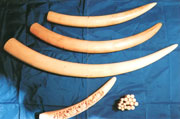Research and Development -Survey and Research on New Methods of Analysis-
The CCL is actively engaged in the development of analysis methods, in order to promptly and accurately analyze imported items that use new materials or that have a complex composition. The CCL conducts research on the results of studies on analysis methods throughout the world and leading-edge analysis techniques to enhance the analysis methods used by Customs. As described, the CCL provides the diversified support for the purpose of improving the analysis techniques of Customs.
Improvement and Development of Analysis Method Concerning Washington Convention
The Washington Convention regulates and restricts trade in endangered species of animals and the products made therefrom, such as ivory or whale meat. The CCL is involved in research on more efficient and accurate analysis methods and uses leading-edge analysis technologies aimed at the prompt identification of products containing the meat or bones of such animals.

Smuggling ivoly
Identification by Analyzing the Protein of Animal Meat
All forms of protein can be broken down into linkages of approximately 20 types of amino acids, and the number and alignment of these amino acids differ in each protein. Different species of meat, such as beef and whale, are judged by using an electrophoresis apparatus to separate the protein components by size.
Identification of Animal Species According to Base Sequence
DNAs are found in nuclei and mitochondria inside cells and have 4 types of constitutional units called "bases." Because the number and alignment of bases vary depending on the given animal species, animals can be identified by using DNA analytical instruments to investigate the base sequence.
Development of Customs Analysis Methods
The types of and materials used in imported products change with the times. New analysis methods that meet the needs of the times need to be developed on a timely basis. However, if each Customs applies a different analysis method for the same item, the analysis result may vary, which in turn may adversely affect the image of the tariff system as a "fair" one. The Customs Analysis Method was therefore established to unify the analysis methods being used in Customs throughout the country and to maintain the fairness of the tariff system.
Requested Analysis
Research and Development
Technical Guidance
